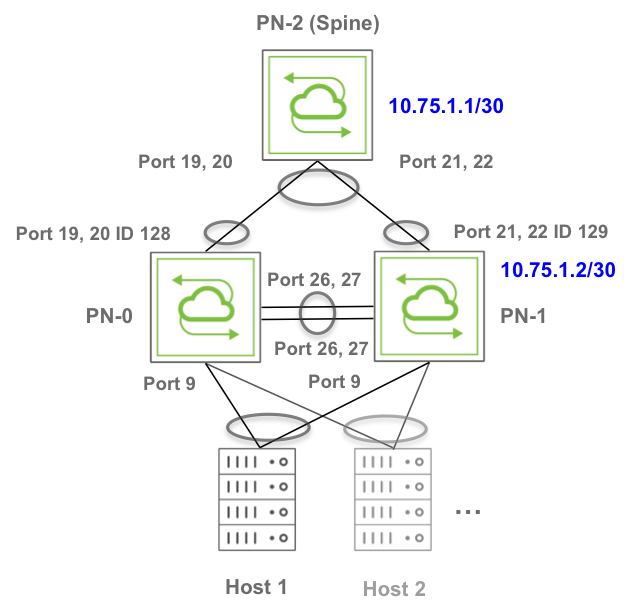Configuring Asymmetric Routing over vLAGs
vLAGs are symmetric Layer 2 redundant paths that work best with symmetric traffic flows. In these cases the aforementioned vLAG forwarding rule works fine, as discussed in the next section.
In case of Layer 3 forwarding over vLAGs, there can exist certain corner-case network designs in which a routing protocol (e.g., BGP or OSPF) is used to peer over a vLAG in an asymmetric fashion.
Let’s consider the example in Figure: Asymmetric Routing over a vLAG in which the network admin has chosen to configure BGP peering only with cluster member PN-1. The downstream hosts are dual-homed and are properly connected to the rest of the network via a default gateway (provided by VRRP).
PN-2 is connected via a vLAG as well to the cluster, however is configured with a /30 subnet that is only present on one cluster member (PN-1 in this example, with PN-2 peering with it via BGP and using the address 10.75.1.1/30).

Figure 7-10 - Asymmetric Routing over a vLAG
If Host 1 wants to talk to PN-2’s 10.75.1.1 (or to another asymmetric route advertised by it), its traffic can go left or right depending on the vLAG load-balancing algorithm. If it goes right, PN-1 can route it to PN-2. However if the traffic goes left, PN-0 has no route it has learned locally to reach PN-2. Therefore, in the best case it will direct traffic over the cluster link (assuming there is some IGP running over it). However, PN-1 will not be able to send the packet to H1 due to the egress filtering rules enforced on vLAGs (see previous section).
For this reason asymmetric routing configurations should be avoided.
However a knob is provided as a last resort to bypass the cluster egress filtering rules in case the customer still wants to utilize this sub-optimal design, which is not recommended. In general, it is sub-optimal for two main reasons:
- Even when there is no failure (vLAG links are up), traffic is forced to cross the cluster links, thereby potentially oversubscribing them.
- There is no redundancy at L3 level. When BGP peering to cluster member PN-1 fails, there is no backup path to direct the traffic to.
To enable support of this design a new configuration option is provided to allow packets crossing the cluster link to be routed without being dropped when egressing vLAGs.
To modify the default configuration use the system-settings-modify routing-over-vlags|no-routing-over-vlags command like so:
CLI (network-admin@switch) > system-settings-modify routing-over-vlags
You can use this command to verify the configuration change:
CLI (network-admin@switch) > system-settings-show
switch: PN-1
routing-over-vlags: on
switch: vanquish4
routing-over-vlags: off
switch: vanquish3
routing-over-vlags: off
